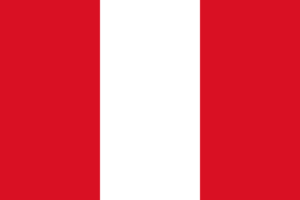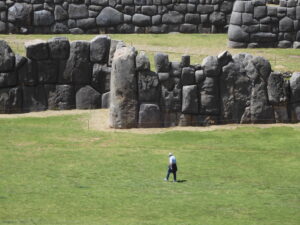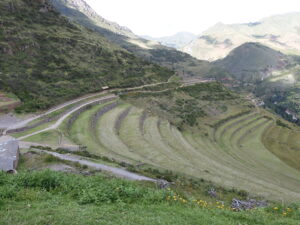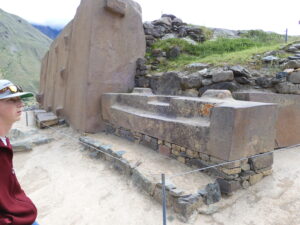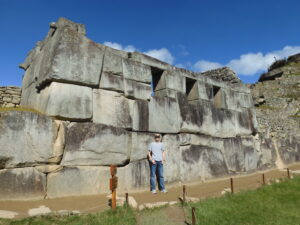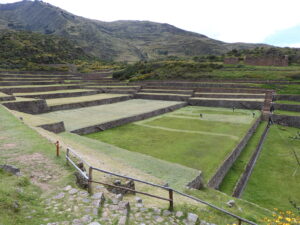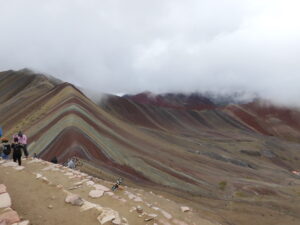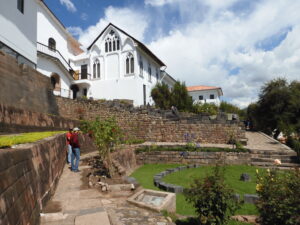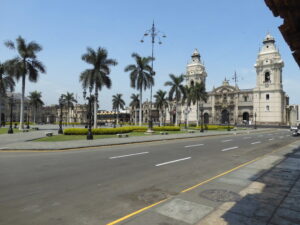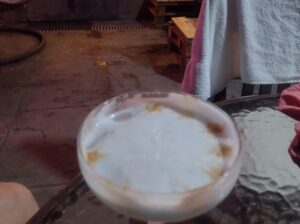Peru Transportation & Accommodation
Where to Stay & How to Get There
Transportation
Peru is a large country. Mercator’s projection might fool you by depicting places along the equator like Peru as smaller than higher latitude countries. Peru is twice the size of Texas – almost as big as Alaska. Beyond that, Peru’s transportation infrastructure makes Peru seem bigger than it is. The road distance between Lima and Cusco is about equal to the distance from my home near Lubbock, Texas to Flagstaff, Arizona, but it takes over twice the time to travel that same distance on Peruvian highways. Whether taking an Uber or a local bus, traversing 20 km (12 miles) from Cusco to an archaeological site in the valley took close to an hour. Most roads are not equivalent to U.S. interstate highways, and even where Peru does have highways, they are strewn with massive speed bumps – speed bumps on the interstate.
As a traveler who appreciates flexibility, I tend to lean toward renting cars as a means of local transportation, especially when there are several travelers in my party. I considered renting a car in Lima, and keeping it for the duration of our stay in Peru. If I had more time, perhaps I would have done so to experience more of the country. Since we had just 12 days in Peru, I did not want to spend four of them driving to Cusco and back. We flew from Lima to Cusco, which cut the time from well over twenty hours to about one. The chaotic nature of driving in Latin America is another mark against renting a car, though I still brave it when logistics favor renting.
Lima has an extensive bus network, but despite speaking Spanish at low intermediate level, I could not figure out where a given bus was going. The buses were an inexpensive option that would have been worth spending more time learning if we were staying more than a day. It proved more effective for us to Uber around town which was still inexpensive, avoided the endless parade of urban stops, and averted the need to learn the city’s complex web of bus lines. Jorge Chavez International Airport is a 45 minute drive from Miraflores or Barranco, making that Uber ride correspondingly more expensive.
There are a few Railways in Peru, but these are more a part of the tourist experience than they are part of the country’s transportation infrastructure. Trains designed to enhance the Machu Picchu experience take you from Ollantaytambo to Aguascalientes. You can also get to Lake Titicaca via train. As always, trains offer a relaxing way to see part of the country as you roll by. We took trains on our way to and from Machu Picchu, and found them enjoyable, but not particularly luxurious. They were frequently behind schedule due to long periods of time waiting on side tracks for opposite direction rail traffic to pass.
The majority of out transportation around Cusco and the surrounding valley was done via Uber or buses. Because of my dad’s aversion to public transportation, we used Uber more often. Other than in isolated areas such as parking lots of archaeological sites, Ubers tended to be readily available. They were very expensive relative to the public transportation. Whether in transportation or lodging, we found there to be a massive price difference between services meant for travelers and services meant for locals. A 20 km trip in an Uber often ran $35-50 U.S., whereas the same distance could be traversed in just a few more minutes for S./3 (about $.70 U.S.). Uber does provide a direct route, and negates the requirement to figure out exactly where the bus lines are going. I tended to opt for the buses when I was alone, and Ubered when I was with dad. I enjoyed the bus experience of seeing what people were doing and where they were going. There were people going to and from work, coming into town and back to sell their wares, children going to school, and sometimes people even willing to talk to the big Gringo.
Accommodations
I was hamstrung by some fairly serious limitations when booking places to stay in Peru. Dad wanted to have his own bed. Preferably we would each have separate beds. We were a group of four men, the shortest of whom stands 6’3”. I managed to keep us all in one room each night. Many of the alternatives would have required us to reserve two rooms. So our choices were fewer than they may be for other travelers.
I found a massive price gap between really nice accommodations by Peruvian standards and motels with amenities Americans take for granted. Most Peruvians do not have hot water in their homes, nor do they have air conditioning. As is the case in every Latin American country I have visited, you are nearly always asked to refrain from putting toilet paper in the toilet. A basket is provided nearby for this purpose. When traveling domestically, it would never occur to me to ask before booking if a motel had hot water or an air conditioner, but if you are expecting these luxuries in Peru, you had better check closely before hitting that non-refundable “book” button.
There are hotels in Peru that would make an American traveler comfortable – by that I mean a traveler not seeking a full Peruvian experience. In both Lima and Cusco, the American style hotels I found ran $300-$400 per night, and tended not to have four beds (doubling our cost by driving us to rent two rooms). I thought to myself, “You are going to Peru, see if you can find places that are very nice, by Peruvian standards.” Dad, on the other hand, is often dissatisfied with middle tier American hotel chains.
For our first stay in Lima, I found the Llaqta Wasi motel. I booked this room because it could accommodate four people in a single room at a cost of $72. This turned out to be a private family room in a hostel. The latter fact was not advertised, but I was not bothered by it. The room was quite cramped. The beds had only a narrow path to walk between them. I was not bothered by this, as when I am traveling I try to minimize the my time in the room. Dad, however, was annoyed by this. Our room did have hot water, but no air conditioning. Lima was a little warm, but I slept fine with the fan on, which doubled as a white noise generator. Our stay included a modest breakfast, and I met some interesting people, as is often the case in hostels. The lesson I learned from this is that hostels advertising on hotel booking sites don’t always advertise themselves as hostels. If, like me, you don’t have a problem with private rooms in hostels, this won’t bother you. If, like my dad, you don’t want to stay at a hostel, then caveat emptor.
I used VRBO to reserve a two story cabin style house in Cusco called Sumaq Wasi. This was a small home, not a motel. We entered a courtyard through a locked door. The courtyard had a school in the front and several modest dwellings built into the walls. The courtyard was shabby and showed signs of city debris here and there, but our host had taken extra special care of the cabin. It was freshly painted and clean. It had four separate beds in a divided loft, with a living area, kitchen and bath below. It did not have air conditioning, but at 12,000’ in Cusco, we didn’t need it. Although the building was not plumbed for hot water, our host had even gone to the trouble of installing a heating element. This was switched on as you started the shower. Since there was only one water pipe, we had to turn the flow down to increase the temperature, and turn the flow up to get cooler water. It was serviceable, and a lot more luxury than the average Peruvian house. We did get the standard admonition against throwing paper in the toilet. We paid only about $350 to stay there for ten days. We even left many of our things there the night we stayed in Aguascalientes. The way I saw it, we were living in the Peruvian equivalent of the green monopoly – the one just before Boardwalk and Park Place – and saving a LOT of money over an American style hotel. For the latter, we would have had to rent two rooms. For the duration of our stay, that would have cost somewhere around $8,000. I did offer my dad the alternative of moving to such a place if this one proved unacceptable to him. He never felt free to insist we move, but was also never comfortable with the less-than-American style digs.
Had dad remained with us for our second sojourn in Lima, he would have liked that hotel better. It was a dated high rise. The exterior looked very nice. The carpet was old and commercial looking, but we had a nice view, were provided a hearty all-you-can eat breakfast, and the air conditioning worked great. There was even a bidet, though I have to admit to not even knowing how to work one. All of this we got for a mere $77 per night. This may be a fortune in Peruvian terms, but it seemed like a reasonable option. I believe we only got this rate by booking at the last minute when they were running a special on rooms.
We spent the night before our Machu Picchu visit at the Sacred Stone Boutique Motel in Aguascalientes. We left most of our baggage and clothing at the cabin in Cusco. Affordable accommodations there granted us the luxury of not toting everything we brought. The boys and I had traveled light, but dad brought heavy baggage. We entered this motel through an empty restaurant and waited twenty minutes before tracking down a desk worker. Once we found them, our hosts were some of the most welcoming people we encountered on the trip. They provided a clean room with four beds. We had hot and cold water, and plenty of fans but no air conditioner. We did not need it, but in warm humid seasons guests may want air conditioning. The nearby Urubamba River generates a soothing rush of white noise throughout the night. Our hosts provided a generous continental breakfast even loaned us an umbrella as there was rain in the forecast. It turns out umbrellas are forbidden at Machu Picchu, but this gesture illustrated the above and beyond attitude our hosts showed – all for the cost of $77 per night. Other facilities may be a bit more luxurious, but no one could have matched the friendliness per dollar.
In summary, there seemed to be a huge disparity in price between an American style hotel and accommodations typical of Peru, without many options in between. Our experience was likely limited by our narrowly defined room requirements and differing preferences in our party.

